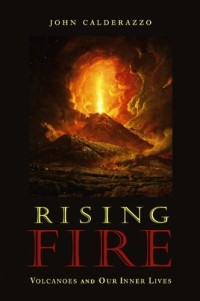Rising Fire: Volcanoes and Our Inner Lives

 By John Calderazzo.
By John Calderazzo.
Published by The Lyons Press, Guilford, CT, 2004.
The painting on the jacket cover, by Joseph Wright of Derby, c.1774-76, is titled An Eruption of Vesuvius, seen from Portici. Click to Buy this Book!
A teacher of creative writing at Colorado State University, John Calderazzo completed an extracurricular project of writing a children’s book about volcanoes that raised questions for him “that deserved a deeper, more complicated consideration appropriate for adults.” He also received a CSU teaching award as the school year was winding down and, an experienced traveler, he decided to visit Sicily’s Mount Etna, that was still erupting (he does not give the year, but this must have been 1993). Rising Fire is primarily an account of his travels to some of the world’s most notorious volcano sites: Mount Etna, Vesuvius, Stromboli, Kilauea, Parícutin, Soufriere Hills (Montserrat), Mount Pelée (Martinique), and Mount Rainier. Mixed in with the largely vernacular travel accounts (“By Monday, I’d had it with conspiracy theories and was badly in the mood for some Scientific Smarts …”) is an abundance of both entertaining and very serious subjects, including local history, quotations from literature, stories and folklore, reminiscences, a treatise on the outer layers and the interior of the earth, ritual sacrifice, and descriptions of volcanic disasters and deaths, e.g., the 1991 deaths of Maurice and Katia Krafft and photographers and reporters in a pyroclastic eruption on Japan’s Unzen. There are also descriptions of such physical sensations as lava moving underground beneath one’s feet at Kilauea, or, three thousand feet up, the sound of the dragon exhaling on Stromboli Island.
The biographical chronology of the author’s experiences is difficult to extract because of his writing style and the profusion of subjects, but it is in the biography and in the many reminiscences that the secondary theme of “Our Inner Lives” emerges. Calderazzo grew up in Brooklyn, New York. He was “23 or 24” years old (he does not say which) in the summer of 1971, when he “first laid eyes on Shasta” in California. He was then a would-be writer, had recently completed college in Tampa, Florida, and had decided to live on “sunshine and metaphors” for a time in the great American West. In 1983 his father died, and this memory becomes a part of Calderazzo’s profound musings on mortality and death. He perceives in the final breaths of his father “the sound of the earth rising within him, reaching up for him, because he refused to move down on his own.” In 1984 he and his wife, SueEllen Campbell, taught college English in Xian, northern China; in 1985 he was successfully treated for a life-threatening skin lesion; and in 1986 he began teaching at CSU. From the Prologue: “Volcanoes were helping me find solace in the liquid nature of rock, in the impermanent nature of everything, including me.” Calderazzo describes himself as a “dreamer,” but he is clearly searching, like a disciplined scientist, for facts and substantial answers about life and death from geology and volcanology. In the rising fires of volcanoes he becomes increasingly aware of death processes out of which will emerge new life. More »